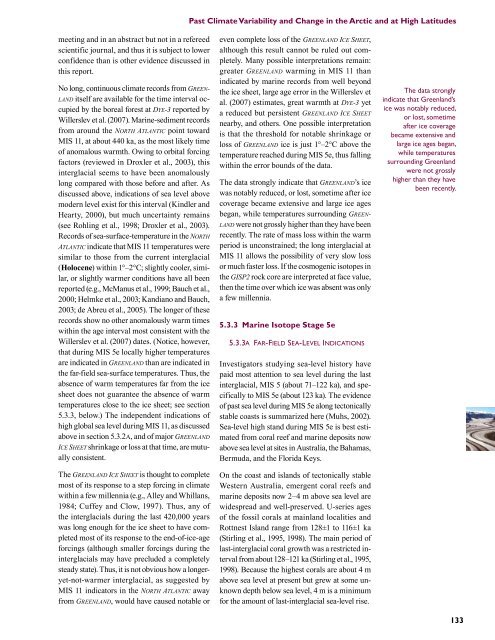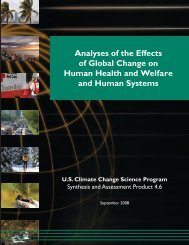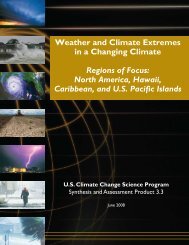Past Climate Variability and Change in the Arctic and at High Latitudes
Past Climate Variability and Change in the Arctic and at High Latitudes
Past Climate Variability and Change in the Arctic and at High Latitudes
You also want an ePaper? Increase the reach of your titles
YUMPU automatically turns print PDFs into web optimized ePapers that Google loves.
meet<strong>in</strong>g <strong>and</strong> <strong>in</strong> an abstract but not <strong>in</strong> a refereed<br />
scientific journal, <strong>and</strong> thus it is subject to lower<br />
confidence than is o<strong>the</strong>r evidence discussed <strong>in</strong><br />
this report.<br />
No long, cont<strong>in</strong>uous clim<strong>at</strong>e records from GreenlAnd<br />
itself are available for <strong>the</strong> time <strong>in</strong>terval occupied<br />
by <strong>the</strong> boreal forest <strong>at</strong> dYe-3 reported by<br />
Willerslev et al. (2007). Mar<strong>in</strong>e-sediment records<br />
from around <strong>the</strong> north AtlAntic po<strong>in</strong>t toward<br />
MIS 11, <strong>at</strong> about 440 ka, as <strong>the</strong> most likely time<br />
of anomalous warmth. Ow<strong>in</strong>g to orbital forc<strong>in</strong>g<br />
factors (reviewed <strong>in</strong> Droxler et al., 2003), this<br />
<strong>in</strong>terglacial seems to have been anomalously<br />
long compared with those before <strong>and</strong> after. As<br />
discussed above, <strong>in</strong>dic<strong>at</strong>ions of sea level above<br />
modern level exist for this <strong>in</strong>terval (K<strong>in</strong>dler <strong>and</strong><br />
Hearty, 2000), but much uncerta<strong>in</strong>ty rema<strong>in</strong>s<br />
(see Rohl<strong>in</strong>g et al., 1998; Droxler et al., 2003).<br />
Records of sea-surface-temper<strong>at</strong>ure <strong>in</strong> <strong>the</strong> north<br />
AtlAntic <strong>in</strong>dic<strong>at</strong>e th<strong>at</strong> MIS 11 temper<strong>at</strong>ures were<br />
similar to those from <strong>the</strong> current <strong>in</strong>terglacial<br />
(Holocene) with<strong>in</strong> 1°–2°C; slightly cooler, similar,<br />
or slightly warmer conditions have all been<br />
reported (e.g., McManus et al., 1999; Bauch et al.,<br />
2000; Helmke et al., 2003; K<strong>and</strong>iano <strong>and</strong> Bauch,<br />
2003; de Abreu et al., 2005). The longer of <strong>the</strong>se<br />
records show no o<strong>the</strong>r anomalously warm times<br />
with<strong>in</strong> <strong>the</strong> age <strong>in</strong>terval most consistent with <strong>the</strong><br />
Willerslev et al. (2007) d<strong>at</strong>es. (Notice, however,<br />
th<strong>at</strong> dur<strong>in</strong>g MIS 5e locally higher temper<strong>at</strong>ures<br />
are <strong>in</strong>dic<strong>at</strong>ed <strong>in</strong> GreenlAnd than are <strong>in</strong>dic<strong>at</strong>ed <strong>in</strong><br />
<strong>the</strong> far-field sea-surface temper<strong>at</strong>ures. Thus, <strong>the</strong><br />
absence of warm temper<strong>at</strong>ures far from <strong>the</strong> ice<br />
sheet does not guarantee <strong>the</strong> absence of warm<br />
temper<strong>at</strong>ures close to <strong>the</strong> ice sheet; see section<br />
5.3.3, below.) The <strong>in</strong>dependent <strong>in</strong>dic<strong>at</strong>ions of<br />
high global sea level dur<strong>in</strong>g MIS 11, as discussed<br />
above <strong>in</strong> section 5.3.2a, <strong>and</strong> of major GreenlAnd<br />
ice Sheet shr<strong>in</strong>kage or loss <strong>at</strong> th<strong>at</strong> time, are mutually<br />
consistent.<br />
The GreenlAnd ice Sheet is thought to complete<br />
most of its response to a step forc<strong>in</strong>g <strong>in</strong> clim<strong>at</strong>e<br />
with<strong>in</strong> a few millennia (e.g., Alley <strong>and</strong> Whillans,<br />
1984; Cuffey <strong>and</strong> Clow, 1997). Thus, any of<br />
<strong>the</strong> <strong>in</strong>terglacials dur<strong>in</strong>g <strong>the</strong> last 420,000 years<br />
was long enough for <strong>the</strong> ice sheet to have completed<br />
most of its response to <strong>the</strong> end-of-ice-age<br />
forc<strong>in</strong>gs (although smaller forc<strong>in</strong>gs dur<strong>in</strong>g <strong>the</strong><br />
<strong>in</strong>terglacials may have precluded a completely<br />
steady st<strong>at</strong>e). Thus, it is not obvious how a longeryet-not-warmer<br />
<strong>in</strong>terglacial, as suggested by<br />
MIS 11 <strong>in</strong>dic<strong>at</strong>ors <strong>in</strong> <strong>the</strong> north AtlAntic away<br />
from GreenlAnd, would have caused notable or<br />
<strong>Past</strong> <strong>Clim<strong>at</strong>e</strong> <strong>Variability</strong> <strong>and</strong> <strong>Change</strong> <strong>in</strong> <strong>the</strong> <strong>Arctic</strong> <strong>and</strong> <strong>at</strong> <strong>High</strong> L<strong>at</strong>itudes<br />
even complete loss of <strong>the</strong> GreenlAnd ice Sheet,<br />
although this result cannot be ruled out completely.<br />
Many possible <strong>in</strong>terpret<strong>at</strong>ions rema<strong>in</strong>:<br />
gre<strong>at</strong>er GreenlAnd warm<strong>in</strong>g <strong>in</strong> MIS 11 than<br />
<strong>in</strong>dic<strong>at</strong>ed by mar<strong>in</strong>e records from well beyond<br />
<strong>the</strong> ice sheet, large age error <strong>in</strong> <strong>the</strong> Willerslev et<br />
al. (2007) estim<strong>at</strong>es, gre<strong>at</strong> warmth <strong>at</strong> dYe-3 yet<br />
a reduced but persistent GreenlAnd ice Sheet<br />
nearby, <strong>and</strong> o<strong>the</strong>rs. One possible <strong>in</strong>terpret<strong>at</strong>ion<br />
is th<strong>at</strong> <strong>the</strong> threshold for notable shr<strong>in</strong>kage or<br />
loss of GreenlAnd ice is just 1°–2°C above <strong>the</strong><br />
temper<strong>at</strong>ure reached dur<strong>in</strong>g MIS 5e, thus fall<strong>in</strong>g<br />
with<strong>in</strong> <strong>the</strong> error bounds of <strong>the</strong> d<strong>at</strong>a.<br />
The d<strong>at</strong>a strongly <strong>in</strong>dic<strong>at</strong>e th<strong>at</strong> GreenlAnd’s ice<br />
was notably reduced, or lost, sometime after ice<br />
coverage became extensive <strong>and</strong> large ice ages<br />
began, while temper<strong>at</strong>ures surround<strong>in</strong>g GreenlAnd<br />
were not grossly higher than <strong>the</strong>y have been<br />
recently. The r<strong>at</strong>e of mass loss with<strong>in</strong> <strong>the</strong> warm<br />
period is unconstra<strong>in</strong>ed; <strong>the</strong> long <strong>in</strong>terglacial <strong>at</strong><br />
MIS 11 allows <strong>the</strong> possibility of very slow loss<br />
or much faster loss. If <strong>the</strong> cosmogenic isotopes <strong>in</strong><br />
<strong>the</strong> GiSp2 rock core are <strong>in</strong>terpreted <strong>at</strong> face value,<br />
<strong>the</strong>n <strong>the</strong> time over which ice was absent was only<br />
a few millennia.<br />
5.3.3 Mar<strong>in</strong>e Isotope Stage 5e<br />
5.3.3a far-fiEld sEa-lEVEl <strong>in</strong>dic<strong>at</strong>ions<br />
Investig<strong>at</strong>ors study<strong>in</strong>g sea-level history have<br />
paid most <strong>at</strong>tention to sea level dur<strong>in</strong>g <strong>the</strong> last<br />
<strong>in</strong>terglacial, MIS 5 (about 71–122 ka), <strong>and</strong> specifically<br />
to MIS 5e (about 123 ka). The evidence<br />
of past sea level dur<strong>in</strong>g MIS 5e along tectonically<br />
stable coasts is summarized here (Muhs, 2002).<br />
Sea-level high st<strong>and</strong> dur<strong>in</strong>g MIS 5e is best estim<strong>at</strong>ed<br />
from coral reef <strong>and</strong> mar<strong>in</strong>e deposits now<br />
above sea level <strong>at</strong> sites <strong>in</strong> Australia, <strong>the</strong> Bahamas,<br />
Bermuda, <strong>and</strong> <strong>the</strong> Florida Keys.<br />
On <strong>the</strong> coast <strong>and</strong> isl<strong>and</strong>s of tectonically stable<br />
Western Australia, emergent coral reefs <strong>and</strong><br />
mar<strong>in</strong>e deposits now 2–4 m above sea level are<br />
widespread <strong>and</strong> well-preserved. U-series ages<br />
of <strong>the</strong> fossil corals <strong>at</strong> ma<strong>in</strong>l<strong>and</strong> localities <strong>and</strong><br />
Rottnest Isl<strong>and</strong> range from 128±1 to 116±1 ka<br />
(Stirl<strong>in</strong>g et al., 1995, 1998). The ma<strong>in</strong> period of<br />
last-<strong>in</strong>terglacial coral growth was a restricted <strong>in</strong>terval<br />
from about 128–121 ka (Stirl<strong>in</strong>g et al., 1995,<br />
1998). Because <strong>the</strong> highest corals are about 4 m<br />
above sea level <strong>at</strong> present but grew <strong>at</strong> some unknown<br />
depth below sea level, 4 m is a m<strong>in</strong>imum<br />
for <strong>the</strong> amount of last-<strong>in</strong>terglacial sea-level rise.<br />
The d<strong>at</strong>a strongly<br />
<strong>in</strong>dic<strong>at</strong>e th<strong>at</strong> Greenl<strong>and</strong>’s<br />
ice was notably reduced,<br />
or lost, sometime<br />
after ice coverage<br />
became extensive <strong>and</strong><br />
large ice ages began,<br />
while temper<strong>at</strong>ures<br />
surround<strong>in</strong>g Greenl<strong>and</strong><br />
were not grossly<br />
higher than <strong>the</strong>y have<br />
been recently.<br />
133




